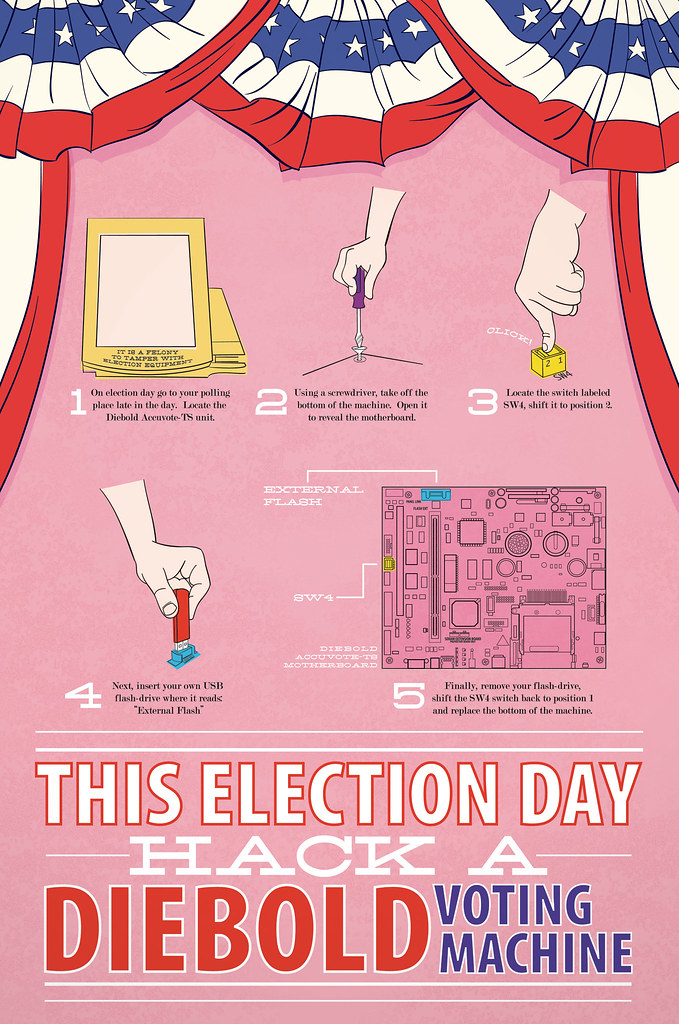
Steal an election with Diebold Accuvote TS machine in one minute
Some Princeton researchers made a demonstration video of how it's possible to steal an election with a Diebold voting machine in under a minute. Anyone with physical access to the machine can put in malicious software to steal votes—such as election workers who have unsupervised access to the machines before elections. All they have to do is open up the machine with a key (or pick the lock), remove the old memory card, stick in your own memory card, boot the machine, and it automatically installs any software that was on the memory card.
At the end of the demonstration election, the poll machine prints out the incorrect "stolen election" result. The internal memory card also stores in the incorrect result. Every piece of evidence of how the election actually went reflects the "wrong" result. And, after the election is over, the vote stealing software can delete itself. There's no evidence left that the vote has been conducted incorrectly.
There's even a flaw in Diebold machines that allow a virus to spread from machine to machine, infecting a memory card and using it to spread to other machines. – Jason Chen
New Hampshire has no touchscreen voting. None.
Every ballot cast in New Hampshire except those few cast by the handicapped is written on a piece of paper. It's redundant to say this after the previous comment about touchscreen voting, but let's make it clear: in New Hampshire there is a paper trail.
The Diebold Accuvote-TS has been shown to be a piece of crap. The Diebold Accuvote-OS, the machine used in New Hampshire, has much of the same hardware and runs much of the same tabulation software, so these machines could conceivably be hacked. However, the incentive for hacking them is not very great, because unlike with the paperless voting, again, there's the paper trail. So if there were ever a recount—and there was after the 2004, when a survey of New Hampshire voting districts chosen by the Nader campaign showed there was virtual no difference between the scanned tabulation and the hand recount—the malfeasance would be easily discovered.
Many folks immediately suspect that any election results they found surprising—and whether they know enough about local and statewide voting patterns to be surprised is always a good question—are most easily explained by malfeasance by the Diebold corporation or exploitation of its machines. There are many problems for these folks who look for the most exotic (and maybe reassuring) explanation for an election result they don't like, but in this case, let's start out with a fairly basic one: voters in every town in New Hampshire cast their vote on a paper ballot, and in more than half of the towns in New Hampshire, the paper ballots are counted by hand.
"S.C. to use voting machines banned in other states"
GREENVILLE — South Carolina election officials say they still plan to use touch-screen voting machines despite the fact that other states have banned the use of similar systems made by the same company.
Last month, top election officials in Ohio and Colorado declared that Election Systems and Software's iVotronic is unfit for elections. The ban was prompted by a study done for the state of Ohio in which researchers found electronic voting systems could be corrupted with magnets or handheld electronic devices such as Palm Treos.
"We've reviewed the report and we remain confident in the security and accuracy of South Carolina's voting system," state Election Commission spokesman Chris Whitmire said. But the South Carolina League of Women Voters has renewed its call for the state to record votes on paper as well as electronically to allow for accuracy checks, though there have been no documented cases of actual election tampering.
"It's very difficult to get evidence that somebody tampered with the vote if you have no way of knowing what the vote was before they tampered," said Eleanor Hare, a computer scientist who participated in a study of the machines by the South Carolina League of Women Voters.
1 comment:
I am a clerk in a Sarasota County precinct. We have used the ES&S touchscreens for years with no hacking problems. If the election team is astute as they should be, it can't be done. We switched to Diabold optical scan equipment. Most of the time they work. However, they are poorly designed and very prone to problems. If their tabulator is not working, the voter is to deposit his marked ballot into a small bin in the ballot box. However, the bin is so small, the ballot box will have to be opened during voting to remove the voted ballots. Not a good scene for s suspicious public. Also, their computer software is very prone to error during the final tabulation. We never had those problems with ES&S.
Post a Comment